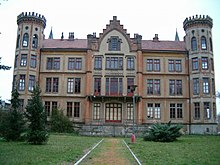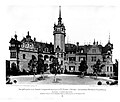Amélie von Reichenbach-Lessonitz
Countess Amélie von Reichenbach-Lessonitz , née Reichsfreiin Amélie Göler von Ravensburg (born April 27, 1838 in Karlsruhe , † March 14, 1912 in Frankfurt am Main ) was the wife of Count Wilhelm von Reichenbach-Lessonitz. She became known as the builder of the Palais Reichenbach-Lessonitz in Frankfurt am Main.
family
Amélie was the daughter of the Baden captain Carl Ludwig Eberhard Leopold Göler von Ravensburg (* 1810 in Sulzfeld, † 1845 in Karlsruhe) and his wife Pauline Auguste Wielandt (* 1813 in Durlach; † 1856 ibid). The Göler von Ravensburg family descends from an old noble family from Kraichgau that belonged to the Swabian Imperial Knighthood and whose ancestral seat, Ravensburg , is near Sulzfeld in Baden-Württemberg .
Life
At the age of 19, she married the 33-year-old Count Wilhelm von Reichenbach-Lessonitz on March 19, 1857 (born June 29, 1824 in Kassel ; † January 19, 1866 in Neuchâtel ). Her husband was the third son of Elector Wilhelm II of Hesse and his second wife, Countess Emilie von Reichenbach-Lessonitz , née Ortlepp. They had two daughters from their nine-year marriage. The younger daughter Caroline (Lilly) (born 1860) died in Stuttgart at the age of 14. The older daughter Pauline (1858–1927) married Prince Alfred zu Löwenstein-Wertheim-Freudenberg (1855–1925) in 1880 .
Her granddaughter Elisabeth Merton, née Princess zu Löwenstein-Wertheim-Freudenberg (1890–1953) was married to Otto Konstantin Prince zu Sayn-Wittgenstein-Berleburg (1878–1955) for the first time. She married the second marriage on March 28, 1930 in Frankfurt am Main, the industrialist and owner of the metal company Richard Merton (1881-1960), who also adopted her children from her first marriage. One of these great-grandchildren, Casimir Johannes Prinz zu Sayn-Wittgenstein-Berleburg , was later temporarily treasurer of the CDU Hessen .
Real estate
Palais Reichenbach-Lessonitz in Frankfurt
Countess Amélie von Reichenbach-Lessonitz had the neo-baroque Palais Reichenbach-Lessonitz built as a widow 's residence at Taunusstrasse 14 in Frankfurt am Main from 1891/1892 . She chose the well-known architects Ludwig Neher and Aage von Kauffmann for the designs and plans . The palace burned down in 1944 after a bomb attack on Frankfurt am Main. During the Nazi rule, an SS command staff confiscated the building. In 1953 the property was sold by the heirs to the Wilhelm Hagen accumulator factory , which erected a functional office building here. In the early 1970s, the Hyatts hotel group wanted to build a hotel on this site. These plans came to nothing, so that in 1972 Deutsche Bank finally acquired the property and had its two high-rise buildings (so-called debit and credit ) built here as headquarters.
Eugensberg Castle , around 1850
Eugensberg Castle in Switzerland
Eugensberg Castle is located in Salenstein near Ermatingen in the canton of Thurgau in Switzerland on the south bank of the Untersee opposite the island of Reichenau . Like many of the other castles on Lake Constance , this castle also has an eventful history. It was the property of Napoleon's stepson Eugen Beauharnais , and later Wilhelm Graf von Reichenbach-Lessonitz bought it to give his wife Amélie as a morning gift as a wedding present. Countess Amélie used Eugensberg Castle for her regular annual summer stays until her death.
Bisenz Castle in Moravia
Between 1823 and 1844, the Hessian elector Wilhelm II was the owner of Bisenz . Here he married his second wife, Countess Emilie von Reichenbach-Lessonitz , née Ortlepp. In 1844, Count Wilhelm von Reichenbach-Lessonitz bought the Bisenz reign from him. After the replacement of patrimonial , the submissive city was given its independence in 1848. Between 1853 and 1855, Wilhelm von Reichenbach-Lessonitz had the castle replaced by a new building in Tudor style . With this building he is said to have taken over financially and therefore ended his life by suicide in 1866 because of his excessive indebtedness . This reason is only mentioned in the chronicle of Bzenec (German Bisenz) and is not sufficiently proven.
Langenzell Castle in Baden
Langenzell is part of the municipality of Wiesenbach and is located in the Rhein-Neckar district on the B 249 ( Neckargemünd -Obrigheim) with an estate and a nursery. It is located between Wiesenbach, Dilsberg and Lobbach about 20 kilometers east of Heidelberg . The so-called "Old Langenzeller Castle" was bought by Wilhelm von Reichenbach-Lessonitz in 1840 - before the marriage to Amélie - along with the estate and agricultural business. In 1880 this property was given by the widow Amélie von Reichenbach-Lessonitz to her son-in-law Prince Alfred zu Löwenstein-Wertheim-Freudenberg . In 1890 the “New Langenzeller Schloss” was built with two wings. It is predominantly designed in the Wilhelminian style in a wooded area and stands in an English park on a small hill above an artificial pond and is considered Germany's youngest new palace to be built. The Löwenstein-Wertheim-Freudenberg family has not used the entire property for a long time. In 2010 the “New Langenzeller Schloss” was sold to a new private investor after years of leasing and is no longer open to the public. There have long been various craft and artistic businesses in the estate itself.
New castle 1895
Wilhelmshütte (Dautphetal) in Hesse
In 1852, Count Wilhelm von Reichenbach-Lessonitz bought the former Kilianshütte ironworks , which has now been renamed Wilhelmshütte after the new owner . After his death, Countess Amélie von Reichenbach-Lessonitz and Princess Pauline zu Löwenstein-Wertheim-Freudenberg inherited the Wilhelmshütte.
Burial place
Countess Amélie was first buried in the hereditary funeral at Ermatingen at the side of her husband. After the elaborate family mausoleum for the Count von Reichenbach-Lessonitz family had been completed in Frankfurt's main cemetery , it was transferred to Frankfurt am Main on February 21, 1913.
Footnotes
Web links
- Reichenbach-Lessonitz, Helene Amélie Countess of. Hessian biography (as of April 27, 2016). In: Landesgeschichtliches Informationssystem Hessen (LAGIS). Hessian State Office for Historical Cultural Studies (HLGL), accessed on July 7, 2016 .
- On the history of Bzenec Castle
- Grave slab of Amélie Countess von Reichenbach-Lessonitz in the Reichenbach-Lessonitz mausoleum in Frankfurt's main cemetery
- Grave slab of Wilhelm Graf von Reichenbach-Lessonitz in the mausoleum Reichenbach-Lessonitz in the Frankfurt main cemetery
- Reichenbach-Lessonitz mausoleum in Frankfurt's main cemetery
- Photo of the husband Wilhelm Graf von Reichenbach-Lessonitz
| personal data | |
|---|---|
| SURNAME | Reichenbach-Lessonitz, Amélie von |
| ALTERNATIVE NAMES | Göler von Ravensburg, Amélie (maiden name) |
| BRIEF DESCRIPTION | German nobles |
| DATE OF BIRTH | April 27, 1838 |
| PLACE OF BIRTH | Karlsruhe |
| DATE OF DEATH | March 14, 1912 |
| Place of death | Frankfurt am Main |







